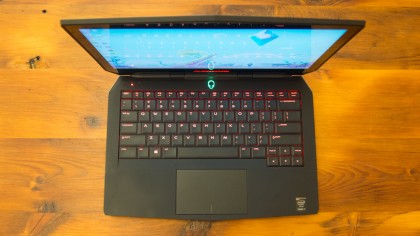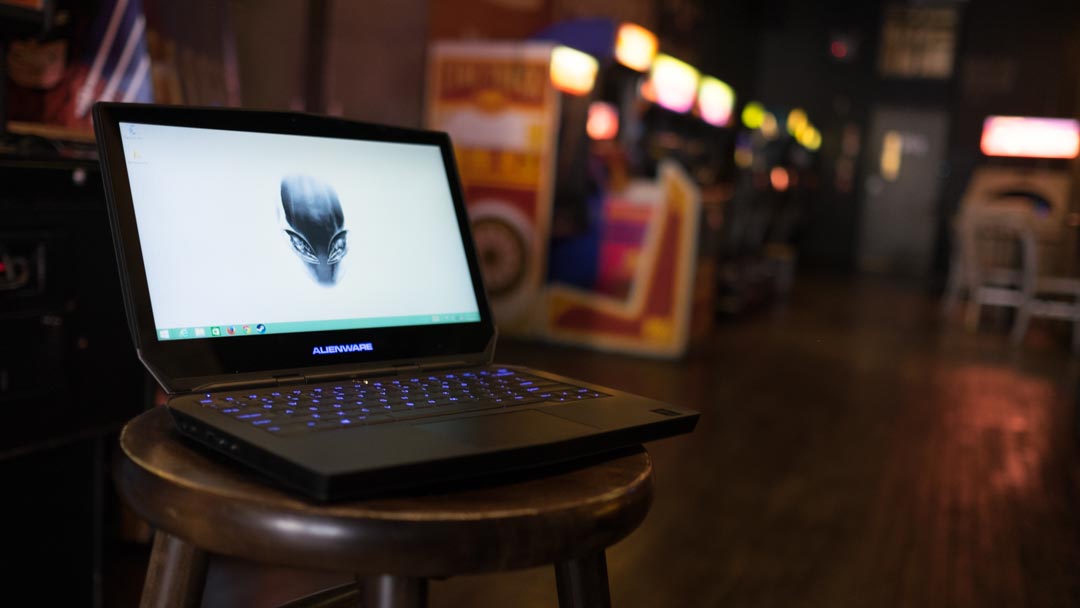Why you can trust TechRadar
The Alienware 13 is a thin, attractive gaming laptop that enters the market at the aggressively low price of $949 to start. Alone, it can handle plenty of basic tasks and even a good share of the latest games at an acceptable clip, albeit tuned down almost all the way.

The Alienware 13 takes off graphically with the Graphics Amplifier plugged in, becoming somewhat of a future-proofed device in doing so. But this presents a dilemma for gamers. I can't imagine that there will be many who are itching to spend up to an extra $800 to unlock the capabilities of something that already cost them close to $1,000, if not more.
We liked
The Alienware 13 isn't the lightest gaming laptop around, but it's a looker. The "Epic Silver" lid looks slick, the build quality is top-notch and the fully customizable LED detailing is a cool touch that you can only find on an Alienware.
Using the laptop is a joy from a usability angle. The ports offer up the flexibility to connect a few accessories and an external screen, if you choose to go down that route. Its keyboard is responsive and the trackpad, while finicky at times, generally provides a smooth experience.
I appreciate that gamers who opt for the low-end machine at $949 are treated to the capable GTX 960M graphics chip found in the rest of the configuration options.
The ability for gamers to upgrade the graphical capabilities of the Alienware 13 through the optional Graphics Amplifier adds value over the long term. Whereas most other gaming laptop owners will need to replace their machine outright when the next big game releases, Alienware 13 owners can scale with the games to come.
We disliked
But at a cost – like, a serious cost. The Alienware 13 makes good on coming in at $949, which is on the lower end of the price spectrum for a gaming laptop. But, once you tack on the Graphics Amplifier, along with a beefy GTX 980 like I tested out, the price tag skyrockets close to, or well over, $2,000.
Sign up for breaking news, reviews, opinion, top tech deals, and more.
Sure, cost is an issue if you choose to purchase the Graphics Amplifier. You don't need to, but my problem is that it feels almost necessary. The relatively limited capabilities of the laptop's internals makes it a little too obvious a nudge from Alienware to purchase the Graphics Amplifier.
Final verdict
By itself, the Alienware 13 is a fine laptop. It's equipped with capable guts for a reasonable price (at least to start) that should keep players plenty entertained. That is, so long as they don't mind knocking the graphical fidelity of games down to low in most cases.
If you won't settle for anything lower than high settings, you'll simply need to spend more money. There's no way around it. The aforementioned Aorus X3 Plus v3 costs a fortune by comparison, but packs in a godly amount of video RAM and might be worth the price, if you're a sucker for graphics.
If the idea of the Graphics Amplifier entices you, the MSI GS30 Shadow also has its own version. While more expensive than most configurations of the Alienware 13, the MSI GS30 Shadow comes with a much more capable quad-core processor (and true 16-pin connection) that really helps that laptop sing when attached to its Gaming Dock.
But if Alienware had its way, you'd just shell out for its Graphics Amplifier. It's an attractive idea that works well, but it's disappointing that the upgrade feels forced if, at the end of the day, even non-enthusiast gamers will be left wanting more out of the Alienware 13.

Cameron is a writer at The Verge, focused on reviews, deals coverage, and news. He wrote for magazines and websites such as The Verge, TechRadar, Practical Photoshop, Polygon, Eater and Al Bawaba.
